Meet the champions for the
conservation of native turtles
Eastern Canada’s freshwater turtles are in serious decline and need our help to survive
By Irwin Rapoport
November 2, 2022
Freshwater and sea turtles have been living on our planet for eons, even surviving the asteroid that decimated most of the dinosaurs when it struck the Yucatán Peninsula around 66 million years ago. They are hardy species and it is interesting to note that the turtles that survived the strike lived side-by-side with early mammals that would eventually evolve into modern-day humans, so we have a shared history going back a long time.
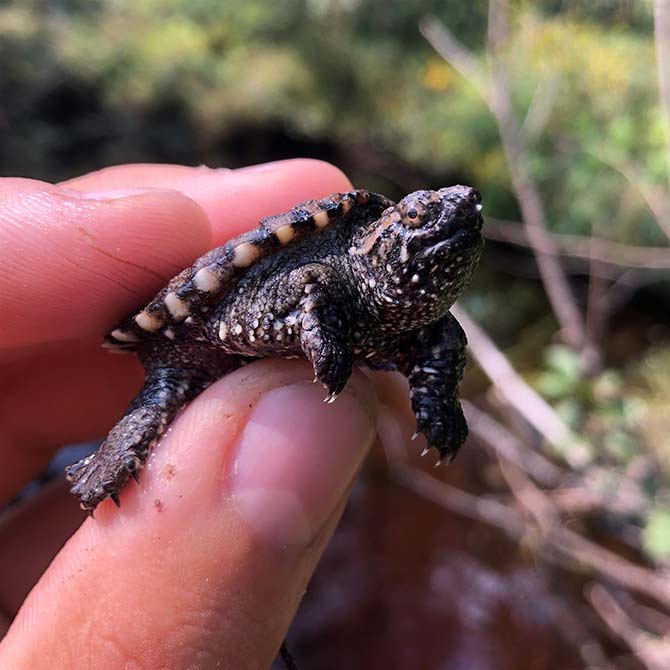
Turtle hatchling released into nature
However, that relationship which started on equal terms now has humanity, through its various activities, serving as the primary cause for the severe decline of turtle populations across the planet, including the eight freshwater turtle species that inhabit Eastern Canada. These are disappearing rapidly due to being killed by cars running over them; habitat loss – the ongoing destruction of wetlands, forests, and fields, including critical nesting and hibernation sites; the construction of roads in prime turtle habitat; pollution; and other factors that, when combined, have led to extirpation in many areas and overall declines. The loss of even one turtle can be catastrophic especially when there are so few and the survival rate of hatchlings into mature adults is low even in the most ideal conditions.
I knew that turtles, like other species, were in trouble but my knowledge turned out to be minimal after I learned more about their plight from Leora Berman, the COO of Turtle Guardians, whose concern for turtles is boundless. Her group and scores of volunteers are making a difference in keeping our turtles alive despite the deadly threats they face daily and have to somehow survive. I learned of Turtle Guardians via a Facebook post that my friend John Phair posted, which immediately caught my attention.
The loss of even one turtle can be catastrophic especially when there are so few and the survival rate of hatchlings into mature adults is low even in the most ideal conditions.
Turtles are reptiles and in Eastern Canada, we have eight species of freshwater turtles and one species of sea turtle, the Leatherback turtle. The First Nations peoples of what is known as North America referred to the continent as Turtle Island and they knew turtles well and respected them. Turtles were not under threat before the arrival of European colonizers and settlers.
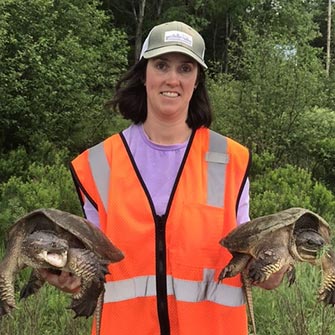
Turtle Guardians volunteer with Snapping turtles
My brother Ronald, after seeing Indiana Jones and the Raiders of the Lost Ark, became enamoured by reptiles. He indeed named his first pet snake Reggie, and not only did he have many snakes but a host of turtles, including a large Snapping turtle in his private zoo on the second floor of our house. He cared about reptiles and their survival and took great care of them.
When I visited Malaysia in 1993, I spent two days at a beach where Leatherback turtles came to nest on an annual basis. A friend and I visited the sea turtle center. We didn’t see any turtles arrive to lay their eggs, but it was a great thrill to check out the beach and make a contribution to the cause. Protecting turtles is essential, and it is very much an international effort. Global warming is having an impact as the rising temperatures are having an effect on the sex of the hatchlings that make it out of the eggs – we have fewer males and traditional nesting sites are being lost due to rising sea levels.
This NASA article describes the threat succinctly. The article states:
“From the day they’re hatched, a sea turtle’s life is a struggle for survival. For every 1,000 sea turtle eggs laid only about one turtle reaches adulthood due to natural predators and other obstacles. Those that do make it face numerous threats from humans. For example, they’re hunted in some regions for their meat, eggs and shells. Their beach habitats get developed. Harmful marine debris and oil spills pollute their waters and beaches.”
“Now, climate change is exposing sea turtles to even greater existential threats. Sea level rise and stronger storms will erode and destroy their beach habitats. Warming oceans will change ocean currents, potentially introducing sea turtles to new predators and harming the coral reefs some of them need to survive.”
“Since the temperature of the beach sand that female sea turtles nest in influences the sex of their offspring during incubation, our warming climate may be driving sea turtles into extinction by creating a shortage of males, according to several studies.”
– Alan Buis, NASA’s Global Climate Change website
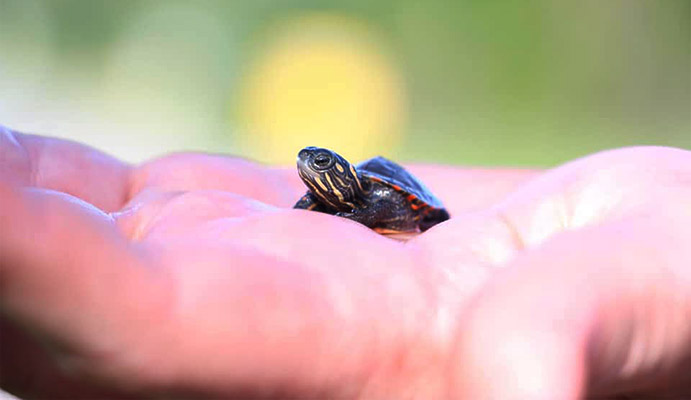
One tiny Painted turtle hatchling
Freshwater turtles face many similar threats and, for the most part, are tied to areas where they are born, which makes the protection of their habitat all the more a priority and a necessity. This September 6 CTV News Montreal report featured the efforts of the Biodome to help restore wild populations of Wood turtles in Quebec by raising hatchlings.
In Ontario, it’s illegal to have a native turtle as a pet.
WM: What can people who own country homes by lakes and rivers do to help place hatchlings along their properties?
Berman: It is illegal to have a native turtle as a pet; it is also illegal to relocate a turtle more than 200 meters. If someone owns a “country” property, the best thing they can do is to keep a large native buffer around any shores to help our native wildlife thrive or even restore shores by planting a shoreland garden – native plants are attractive and can be installed neatly if desired, but still be highly functional.
If there are wetlands, it is important to preserve the wetland basin entirely and not fill or alter the hydrology of the wetland. If turtles are in the area and you see a nesting turtle, you can help them succeed by installing a nest-cage-protector (a screen on a wood frame with openings along the sides for the hatchlings to escape). There are designs on our website, and many partner groups have designs or have them for sale too. Then monitor the nest, and you can report observations to us to help us track population trends.
These links concerning turtles living in Eastern Canada highlight many of the points raised by Berman and provide additional information:
Here are some videos from The Dodo about people helping out wild turtles:
One of the key allies in the struggle to help freshwater turtles is the Canadian Wildlife Federation (CWF). David Seburn, the CWF’s Freshwater Turtle Specialist, in a short Q&A, spoke about the need to protect our turtles and the initiatives that his organization is pursuing to bring awareness of their plight.
WM: Why should we be concerned about turtles, and how can we help them?
Seburn: Turtles, as a group, have been around since the age of the dinosaurs. The dinosaurs went extinct, but turtles survived. Today, all eight species of freshwater turtles in Canada are listed as species at risk by the federal government. This makes turtles one of the most endangered groups of wildlife in Canada.
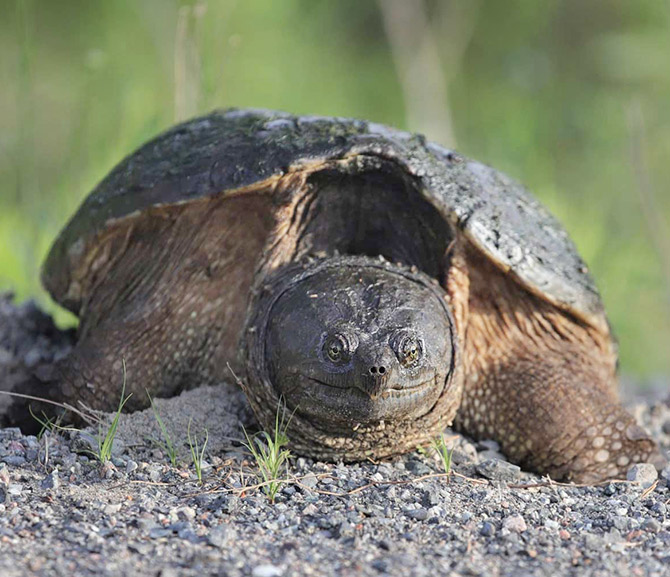
Snapping turtle
One of the biggest threats to turtles is being killed by cars and trucks. Anyone who is driving in rural areas can watch for turtles crossing the road, particularly during June, the nesting season for turtles. Many turtles crossing roads in June are females looking for a safe place to lay their eggs. The loss of one female turtle hit by a car removes her from the population but also all the eggs she would have laid in the years or decades to come. When driving near marshes or lakes, keep an eye open for turtles crossing the road and drive at a slower speed if possible. Check out our video on how to safely help a turtle cross the road.
People can also report their observations of turtles to iNaturalist Canada, a project to document native and exotic species in Canada. Observations of turtles help to better understand where they still occur, what threats they face, and how populations are doing. A single observation may document a previously unknown population of a rare species.
If you live near a marsh or lake and are lucky enough to have turtles nesting around your place, you can protect the eggs by installing a nest protector. Here is a link to our guide on how to build a nest protector.
WM: Could you describe some of the CWF initiatives and how they are making a difference?
Seburn: For the past few years, we have been working on three main issues: increasing the size of turtle populations, increasing habitat protection, and decreasing road mortality. We incubate turtle eggs from nests in risky locations and release the hatchlings back into the wild. We have now released more than 3000 hatchlings. Most of these eggs would have been eaten by predators so this is a huge boost to turtle populations.
We have also conducted surveys for the Blanding’s Turtle, a globally endangered species. Finding Blanding’s Turtles in a new area results in additional habitat protection for that wetland and wetlands around it under the provincial Endangered Species Act of Ontario. To date, we have protected over 100 square kilometres of wetland habitat in eastern Ontario.
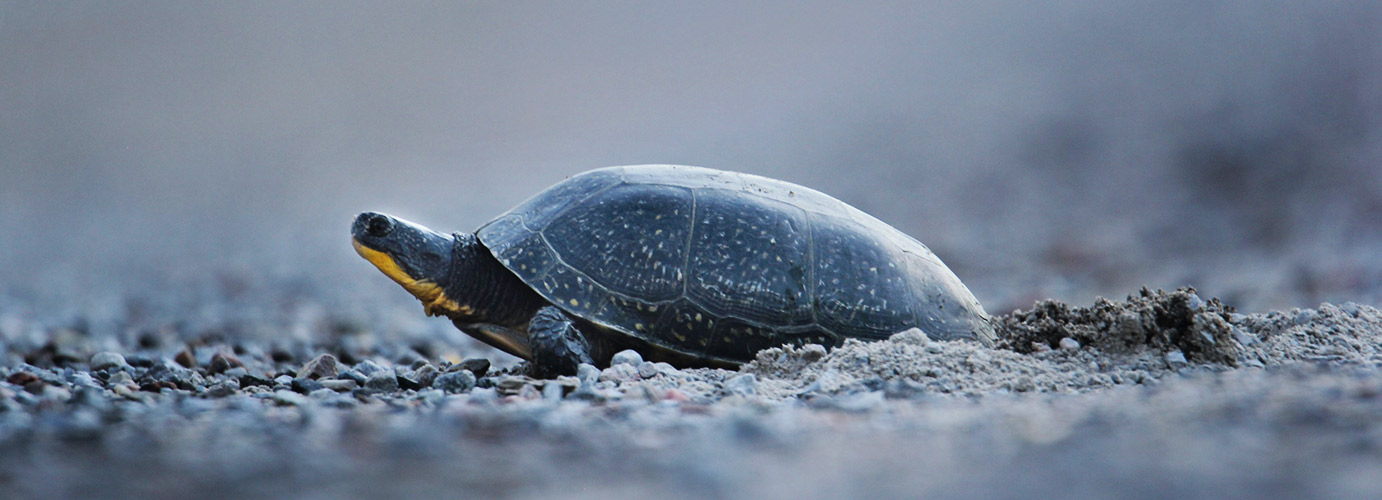
Blanding’s Turtle
We also surveyed turtles on roads to determine the sections of road with the most road mortality. We have documented over 1,500 dead turtles on roads in eastern Ontario. Using these results, we have worked to get wildlife fencing installed at four of the worst sections of roads. The fencing keeps turtles, and other wildlife, off the road, but wildlife can safely cross under the roads using drainage culverts. These fences will save the lives of hundreds of turtles over the next few decades.
WM: How important is it for organizations and individuals who care about turtles to work together and maximize their efforts?
Seburn: Collaboration is vital. We can all learn from each other, improving our techniques and our ability to get things done. It is also easier for a group to get more things done than one person working alone. We work closely with several groups to provide expertise, training, or support.
WM: What can the various levels of government do to help protect existing turtle populations and habitat, and to restore populations to their previous levels? Is there a will at the government level to protect turtles and their habitat?
Seburn: Governments at all levels are doing things to help turtles and other wildlife, either through funding programs, laws, or policies that protect important habitats or the species themselves. There is always more that can be done, but it is up to the public to convince governments that protecting nature and reducing pollution are important.
Feature image: David Seburn with Blanding’s turtle, courtesy of the CWF
Images: courtesy of Turtle Guardians (unless indicated otherwise)
Read also other articles by Irwin Rapoport
 Irwin Rapoport is a freelance journalist with Bachelor degrees in History and Political Science from Concordia University.
Irwin Rapoport is a freelance journalist with Bachelor degrees in History and Political Science from Concordia University.










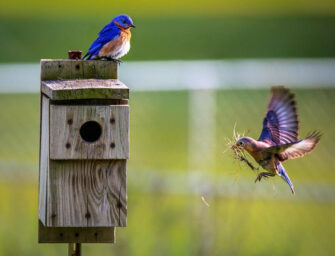


















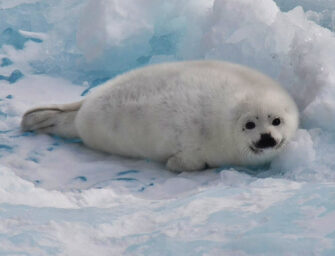






There are no comments
Add yours